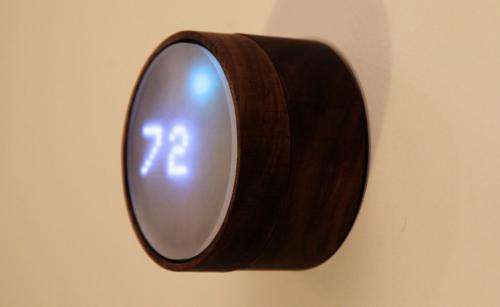(Phys.org) —Spark.io has come up with an open source thermostat. "We spent about $70 on components to put this together (including $39 for the Spark Core); the wood and acrylic were free. We started working at 10am and finished at 3am, with 3.5 engineers involved (one went to bed early), and the only work we did in advance was order the electronic components." Their step by step demo and encouraging words to Makers that the future is quite open for success have attracted a number of tech sites to give them praise. Spark is a Minneapolis, Minnesota based group, founded in 2012, which carries a motto to give you "the tools to connect everyday electronics to the internet over Wi-Fi." The group is known already for the Spark Core, a small Wi-Fi development board that makes it easy to create Internet-connected hardware. They also are known for Spark Cloud, a cloud service for connected devices. This time around, they designed an open source thermostat as a DIY feat. Open source files for this Web-connected thermostat have been posted on GitHub.
The user can change the temperature by turning a ring; the temperature appears on an LED display.
How did they do it, in spending little time and cash to put it all together? They cut out wood and plastic and added Spark Core and control logic. That's the short story. For those who want to understand, though, what they actually had to do to make this work, the Spark team posted a generous discussion, step by step.
First, the hardware. "In our case, that means sensors for temperature and humidity, plus a motion sensor to figure out whether you're home, and relays to control the furnace and the fan. We also need a display so you can see the current temperature, and an enclosure to protect the messy bits." Then they said, they did some "breadboarding" to create an early prototype. They chose the Spark Core as the "connected brain," and showed the temperature on Adafruit LED matrices. The display interface was a I2C bus. The primary sensor was a Honeywell Humidicon temperature and humidity sensor.
Several LEDs could represent whether the heat and fan were on and they added a Panasonic PIR motion detector. They built an enclosure using acrylic and wood. They laser-cut acrylic disks: for a faceplate, for the wall-mounting plate, and for the spinning wooden ring to a potentiometer; they soldered the components.
The thermostat, they said, is complemented with a cloud-based web app that handles the complex logic of the thermostat. "By doing this in the cloud, we can iterate faster using high-level programming languages and frameworks like Ruby on Rails rather than low-level embedded C."
The creators at Spark are proud of their outcome—they did after all build a thermostat in one day and open sourced everything— but they have also made something else clear: "We're not claiming to have matched the Nest thermostat in a day; far from it. But remember—every polished product starts as a rough prototype."
Spark's demo shows the DIY spirit and it also proves people who love building things, especially, connected things, can just do it.
More information:
blog.spark.io/2014/01/17/open-source-thermostat/
www.spark.io/
© 2014 Phys.org






















